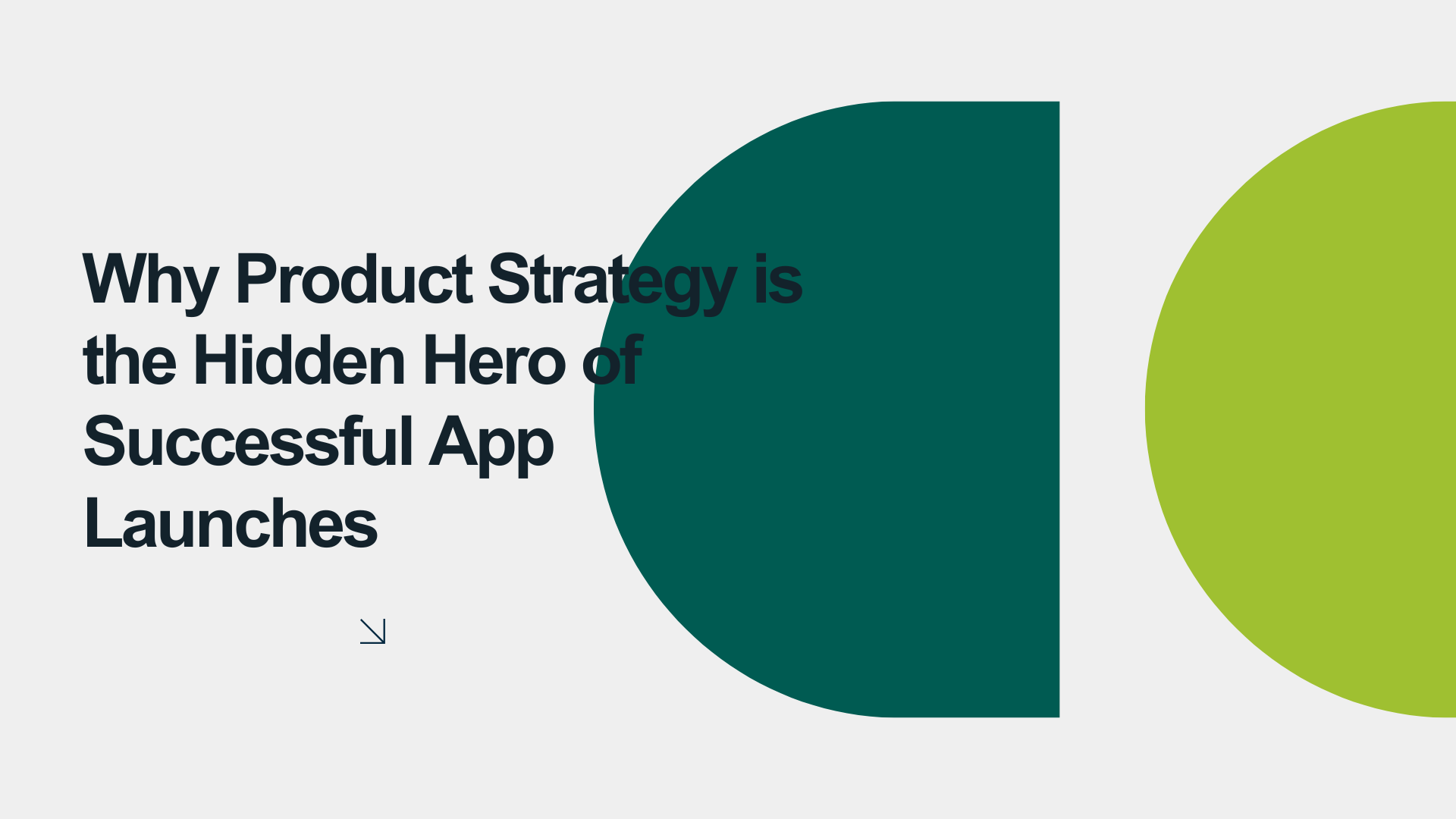In the fast-paced world of app development, there’s an invisible force working behind every successful launch—one that rarely gets the spotlight but makes all the difference between a product that thrives and one that fades into obscurity. That force is product strategy.
While flashy marketing campaigns and sleek user interfaces grab attention, it’s the strategic foundation laid months before launch that determines whether an app will resonate with users, solve real problems, and build sustainable growth. Product strategy is the quiet hero that transforms ambitious ideas into market-ready solutions.
Defining Digital Product Strategy (And Why It’s Not Just Project Planning)
Digital product strategy goes far beyond creating timelines and assigning tasks. It’s the comprehensive blueprint that answers the fundamental questions every successful product must address: Who are we building for? What problem are we solving? How will we differentiate ourselves in the market? And most critically—why should users care?
At its core, product strategy encompasses several key elements:
Market Intelligence: Understanding your competitive landscape, identifying gaps in the market, and recognizing emerging opportunities that others might miss.
User-Centric Design Thinking: Developing deep empathy for your target audience, mapping their pain points, and designing solutions that feel intuitive and valuable from day one.
Technical Feasibility Assessment: Balancing ambitious vision with practical constraints, ensuring your product can be built efficiently without compromising on quality or user experience.
Go-to-Market Planning: Creating a roadmap for how your product will reach users, gain traction, and scale sustainably in a crowded digital marketplace.
Success Metrics Definition: Establishing clear, measurable goals that align with business objectives and provide meaningful insights into product performance.
Unlike project planning, which focuses on execution timelines and resource allocation, product strategy is about making informed decisions that shape the very DNA of your product. It’s the difference between building something because you can and building something because the market needs it.
The Risks of Skipping Product Strategy
The app ecosystem is littered with products that had brilliant execution but failed because they lacked strategic foundation. When teams jump straight into development without proper strategy, several critical risks emerge:
Market Misalignment becomes almost inevitable. Without deep market research and user validation, products often solve problems that don’t exist or target audiences that don’t have the pain points the product addresses. This leads to beautiful apps that nobody uses.
Resource Waste multiplies exponentially. Development teams spend months building features that users don’t want, creating complex solutions for simple problems, or optimizing for metrics that don’t drive business value. The cost isn’t just financial—it’s the opportunity cost of not building what users actually need.
Competitive Disadvantage emerges when products enter markets without understanding how they differentiate from existing solutions. Without strategic positioning, even superior products can struggle to communicate their value proposition effectively.
Scaling Challenges become apparent post-launch when products that seemed promising in testing fail to gain sustainable traction. Without strategic planning for growth, user acquisition, and retention, products often hit plateaus they can’t overcome.
Identity Crisis develops when products try to be everything to everyone. Without clear strategic direction, feature creep sets in, user experience becomes diluted, and the product loses its core value proposition.
These risks compound over time, making course correction increasingly difficult and expensive. The further into development a product gets without solid strategy, the more painful pivots become.
Case in Point: Huupe – The World’s First Smart Basketball Hoop
To understand how product strategy transforms ambitious concepts into market success, consider the journey of Huupe, the world’s first smart basketball hoop. This case study perfectly illustrates how strategic thinking can navigate complex challenges and create entirely new product categories.
The Challenge
Huupe faced a unique set of strategic challenges that required careful navigation. They were creating something that had never existed before—a smart basketball hoop that could track shots, provide coaching feedback, and connect players globally through digital experiences.
The challenge wasn’t just technical; it was fundamentally strategic. How do you introduce a completely new product category to a market that doesn’t know it needs what you’re building? How do you balance cutting-edge technology with the timeless appeal of basketball? How do you price a premium product in a market accustomed to traditional equipment?
The team also faced the complexity of building both hardware and software components that needed to work seamlessly together. The basketball hoop required precise sensors, weather-resistant construction, and reliable connectivity, while the accompanying app needed to provide engaging experiences that would keep users coming back.
Perhaps most challenging was the need to appeal to multiple user personas simultaneously—serious basketball players looking to improve their game, families wanting active entertainment options, and tech enthusiasts excited by innovative sports equipment.
The Strategy
Huupe’s strategic approach demonstrated how thoughtful planning can address complex multi-faceted challenges. Their strategy focused on several key pillars that would become the foundation for everything they built.
Category Creation became their primary strategic focus. Rather than trying to compete in existing markets, they recognized they were creating an entirely new category of smart sports equipment. This required educating the market while simultaneously building excitement around possibilities that didn’t previously exist.
User Experience Integration was critical to their approach. They understood that success would depend not just on the technology working, but on creating seamless experiences that felt natural to basketball players. The strategy involved extensive user testing with players of different skill levels to ensure the smart features enhanced rather than interfered with the game.
Community Building emerged as a central strategic element. They recognized that basketball is inherently social, so their product strategy included features that would connect users, enable friendly competition, and create reasons for ongoing engagement beyond individual practice sessions.
Premium Positioning was a deliberate strategic choice. Rather than trying to compete on price, they positioned Huupe as a premium product that delivered professional-level training insights and entertainment value that justified the investment.
Partnerships and Validation became crucial for market entry. They strategically aligned with basketball influencers, trainers, and technology reviewers who could authentically demonstrate the product’s value to their target audiences.
The Results
The strategic foundation Huupe built translated into remarkable market success that validated their approach. Their product launch exceeded expectations across multiple metrics that matter for sustainable growth.
Market reception was overwhelmingly positive, with early adopters becoming enthusiastic advocates who helped drive organic word-of-mouth marketing. The product successfully created the new category they envisioned, with competitors and media outlets now using their terminology and framework to discuss smart sports equipment.
User engagement metrics demonstrated that their strategy of focusing on seamless integration was successful. Players weren’t just using the product once or twice—they were incorporating it into regular training routines and family activities, indicating strong product-market fit.
The premium positioning strategy proved effective, with customers willing to invest in the product because they understood its unique value proposition. Customer feedback consistently emphasized how the strategic decision to focus on user experience over feature quantity created a product that felt premium and polished.
Perhaps most importantly, Huupe established a foundation for sustainable growth. Their strategic approach created not just a successful product launch, but a platform for ongoing innovation and market expansion that continues to drive their business forward.
Final Thoughts: Strategy is the Quiet Work That Pays Off
Product strategy will never get the same attention as a viral marketing campaign or a beautifully designed interface, but it’s the foundation that makes both possible. It’s the quiet, methodical work of understanding markets, users, and opportunities before the first line of code is written or the first pixel is placed.
The most successful app launches aren’t accidents—they’re the result of strategic decisions made long before anyone sees the final product. They succeed because someone took the time to understand not just what was possible to build, but what was necessary to build.
In a world where anyone can learn to code and design tools are more accessible than ever, product strategy becomes the true differentiator. It’s no longer enough to build something functional and beautiful. Success requires building something that matters to people, solves real problems, and creates sustainable value in the marketplace.
The next time you see an app that seems to have appeared overnight and taken the world by storm, remember that behind that apparent sudden success are months of strategic thinking, planning, and decision-making. Product strategy is the hidden hero working behind the scenes, making everything else possible.
For teams preparing to launch their next product, the question isn’t whether you can afford to invest in strategy—it’s whether you can afford not to. In an increasingly competitive digital landscape, strategy isn’t a luxury. It’s the foundation upon which all sustainable success is built.



